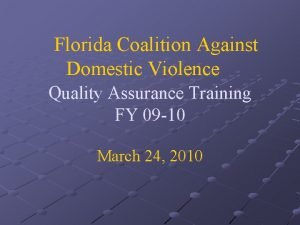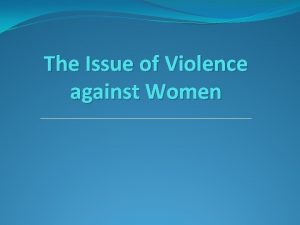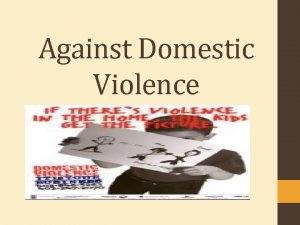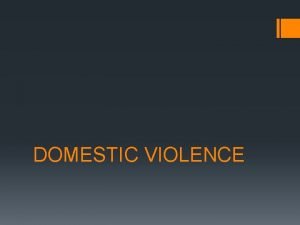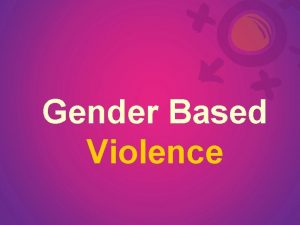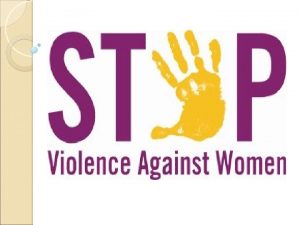Measuring violence against women The Canadian experience Franois
















- Slides: 16

Measuring violence against women: The Canadian experience François Nault Director, Statistics Canada November 2013 1

Statistics Canada data sources to measure violence against women Police-reported administrative surveys § Uniform Crime Reporting Survey § Homicide Survey Self-reported victimization survey § General Social Survey on Victimization Other administrative surveys § Transition Home Survey (shelters for abused women) § Victim Services Survey 2 Statistics Canada • Statistique Canada

Police statistics – Uniform Crime Reporting Survey § Collecting aggregate police statistics since 1962. § In 1988, it began collecting micro data from police services. • Victim and accused characteristics • Incident characteristics • Relationship of victim and accused § Number of police services covered in the micro data increased steadily over the years. The coverage now stands at 99%. 3 Statistics Canada • Statistique Canada

Women almost four times more likely than men to be victims of intimate partner violence, 2011 Rate per 100, 000 population Source: Statistics Canada, Incident-based Uniform Crime Reporting Survey. 4 Statistics Canada • Statistique Canada

Police statistics – Homicide Survey § Homicide Survey began in 1961 § Began collecting data on family-related homicides in 1974 § In 1991, 1997, and 2005, the survey was revised and expanded • • 5 Relationship categories Previous conviction history History of domestic violence Victim’s use of force at the time of the homicide Statistics Canada • Statistique Canada

Rates of intimate partner homicide declined by half in last 20 years Source: Statistics Canada, Homicide Survey. 6 Statistics Canada • Statistique Canada

Advantages and disadvantages of police-reported data Advantages § Annual statistics § Standard measure over time and among cities and provinces § Based on physical evidence and witnesses § Mandatory survey Disadvantages § No victim information exists for non-violent crime, such as financial abuse (e. g. , theft, forgery, fraud) § No information about the consequences of violence beyond physical injury § Includes only those incidents that come to the attention of police, which is a greater issue for intimate partner violence and sexual violence 7 Statistics Canada • Statistique Canada

Self-reported victimization surveys § Canadian Violence Against Women Survey (VAWS) • One-time sample survey of Canadian women aged 15 years and older conducted in 1993 • Conducted by phone § General Social Survey on Victimization • Began in 1988, repeated every five years • Sample survey of Canadians aged 15 years and older • Conducted by phone 8 Statistics Canada • Statistique Canada

Lessons learned from the Violence Against Women Survey (VAWS) • The importance of early and transparent consultation with stakeholders and potential critics to ensure the utility and relevance of the data. • The need to use recognized definitions for measuring social phenomenon (e. g. , Criminal Code). • The need to have collection approaches and mechanisms that are appropriate given the sensitivity of the subject matter (i. e. , sensitivity training, sex of interviewers). • The importance of establishing in advance an analytical framework that will produce policy relevant “information”, not just numbers. 9 Statistics Canada • Statistique Canada

Building from the VAWS experience § Statistics Canada considered options for integrating the survey content within an existing populationbased survey. § It was decided to develop a special module on spousal violence within the General Social Survey (GSS). The questions contained in this module were modelled off the VAWS. 10 Statistics Canada • Statistique Canada

Self-reported victimization surveys Improvements to the GSS with each cycle • 1988: First general victim survey • 1993: Better measures of sexual assault • 1999: Special modules to measure spousal violence, now repeated with every victimization cycle • 2004: Special module on criminal harassment/stalking • 2009: Cybercrime and experiences of victimization before the age of 15 • 2014: Expansion of questions on victimization in childhood and new questions on dating violence and witnessing spousal violence as a child. 11 Statistics Canada • Statistique Canada

Women more likely to experience severe forms of spousal violence, 2009 * * † reference category * significantly different from reference category (p < 0. 05) Source: Statistics Canada, General Social Survey on Victimization. Statistics Canada • Statistique Canada 12

Dealt with another way: Top reason for not reporting spousal violence to police, 2009 * † reference category * significantly different from reference category (p < 0. 05) Source: Statistics Canada, General Social Survey on Victimization. 13 Statistics Canada • Statistique Canada

Advantages and disadvantages of self-reported data Advantages § Allows examination of crime that goes unreported to police § Provides information on non-violent forms of spousal abuse (i. e. , emotional and financial abuse) § Captures information on consequences of victimization, levels of reporting to police, children’s exposure to spousal violence and social service utilization Disadvantages § Possible exclusion of certain population groups of women - those living in institutions and those unable to communicate in English or French § Voluntary: relies on willingness of Canadians to participate § Subject to sampling error 14 Statistics Canada • Statistique Canada

Two additional surveys Transition Home Survey § Mail survey to all shelters in Canada § Bi-annual § Characteristics of shelters and services § One-day snapshot of women and children residents Victim Services Survey § Mail survey to all victim services § Characteristics of victim services § One-day snapshot of victims provided service 15 Statistics Canada • Statistique Canada

Analysis and dissemination § Collecting data on violence against women and men is not enough. Gender-based analysis of data is critical to ensuring the information is relevant to both policy and programs. § Statistics Canada is committed to conducting robust analysis on women’s experience of victimization and making these findings publicly available (e. g. , recent release of ‘Measuring Violence Against Women: Statistical Trends’ - February 2013) § Future efforts will continue to link record within and across surveys to further strengthen analysis and address information gaps. 16 Statistics Canada • Statistique Canada
 Physical violence against women
Physical violence against women Franois villon
Franois villon Franois villon
Franois villon Pic franois
Pic franois Florida coalition against domestic violence
Florida coalition against domestic violence Canadian league against epilepsy
Canadian league against epilepsy Early experience vs. later experience
Early experience vs. later experience Direct experience vs indirect experience
Direct experience vs indirect experience Imprint definition psychology
Imprint definition psychology Tư thế worms-breton
Tư thế worms-breton đại từ thay thế
đại từ thay thế Quá trình desamine hóa có thể tạo ra
Quá trình desamine hóa có thể tạo ra Cong thức tính động năng
Cong thức tính động năng Thế nào là mạng điện lắp đặt kiểu nổi
Thế nào là mạng điện lắp đặt kiểu nổi Dot
Dot Bổ thể
Bổ thể Vẽ hình chiếu đứng bằng cạnh của vật thể
Vẽ hình chiếu đứng bằng cạnh của vật thể




